


ANTHONY VAN DYCK 1599 -
Acknowledgements
Van Dyck: Self-
Including:
Jacob
Jordaens

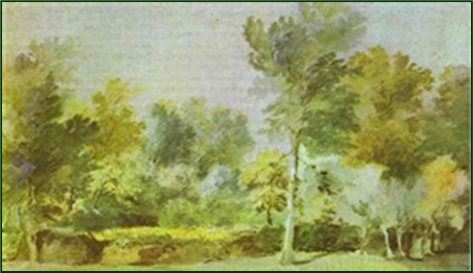 xxxxxSome 500 of his portraits have survived, together with many oil sketches and drawings. His watercolour landscapes, now in the British Museum, captured the very essence of the English countryside, their light touch and simplicity being in marked contrast to his work in oils. Illustrated here is A Meadow, Surrounded by Trees, 1635.
xxxxxSome 500 of his portraits have survived, together with many oil sketches and drawings. His watercolour landscapes, now in the British Museum, captured the very essence of the English countryside, their light touch and simplicity being in marked contrast to his work in oils. Illustrated here is A Meadow, Surrounded by Trees, 1635.
xxxxxVan Dyck, though strong looking in appearance, had a delicate constitution, and in his last years the constant pressure of work took a toll on his general health. Nonetheless, in 1640 he married Mary Ruthven, one of the Queen's ladies-
xxxxxIncidentally, with the aid of the three combined portraits of Charles I, completed in 1635 and sent to Rome the following year, Bernini competed the bust of the king, but it perished in a fire at Whitehall Palace in 1697, and a copy had to be made from an existing cast. We are told that, while working on the bust, the great Italian sculptor was struck by the king's melancholy air and his sense of foreboding! Van Dyck also produced three portraits of the Queen, Henrietta Maria, for a Bernini bust, but by the time they were completed the civil war was under way and they were never sent to Rome.
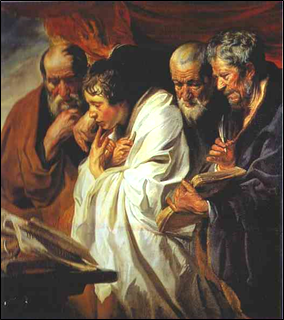 xxxxxJacob Jordaens (1593-
xxxxxJacob Jordaens (1593-
xxxxxHe was born in Antwerp and trained under Adam van Noort. Like Van Dyck, he was a member of the city's art guild and head of a flourishing workshop. After working for Rubens, his fame spread further afield and, following the death of his former master in 1640, he could hardly cope with the number of commissions he received, despite his large team of students.
xxxxxAmong his major works are his early painting The Four Evangelists (illustrated above), his Triumph of Bacchus, and his Christ Driving the Money Changers from the Temple -
xxxxxAnother Flemish artist at this time who worked with and was influenced by Rubens was Jacob Jordaens (1593-
xxxxxThe Flemish artist Anthony van Dyck was one of the outstanding artists of the 17th century. He was an assistant to Peter Paul Rubens and, adopting his master’s vibrant colours and lush style, earned a reputation for his portraiture and religious canvases. While in Italy, studying Titian, Tintoretto and Veronese, he gained fame for his flattering portraits of the aristocracy, and the exquisite rendering of their rich attire. His long association with England began in 1632, where he became principal painter to Charles I and painted him and his family many times. Among his major religious works are his moving Christ Crowned with Thorns, Madonna of the Rosary, and The Rest on the Flight into Egypt. Notable among his mythological studies is his Rindaldo and Armida. Apart from members of Europe’s royal families and aristocracy, his portraits, in excess of 500, included scholars, churchmen and local artists.
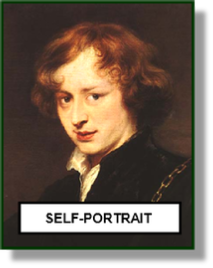 xxxxxAnthony van Dyck, one of the outstanding artists of the 17th century, was born in Antwerp of a wealthy family. Such was his precocious talent that he opened his own studio at the age of 16, and was accepted as a member of the Antwerp guild of painters two years later. He then spent two formative years (1618-
xxxxxAnthony van Dyck, one of the outstanding artists of the 17th century, was born in Antwerp of a wealthy family. Such was his precocious talent that he opened his own studio at the age of 16, and was accepted as a member of the Antwerp guild of painters two years later. He then spent two formative years (1618-
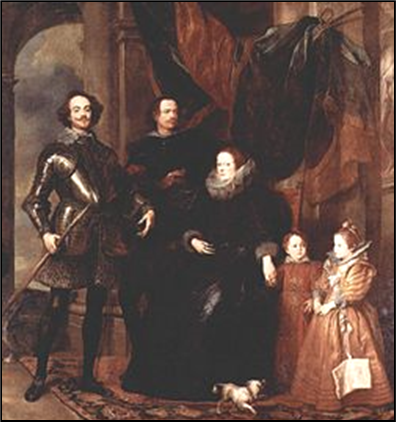 xxxxxInvited by the Earl of Arundel, he then paid a short visit of three months to the court of James I of England, before spending six years in Italy, travelling, studying and painting. He was particularly impressed with the work of the Venetians -
xxxxxInvited by the Earl of Arundel, he then paid a short visit of three months to the court of James I of England, before spending six years in Italy, travelling, studying and painting. He was particularly impressed with the work of the Venetians -
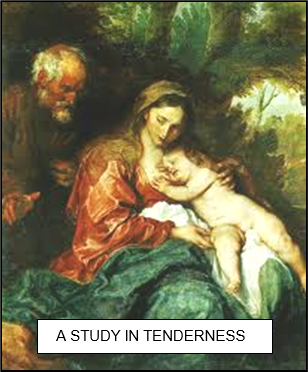
xxxxxOn returning to his native city in 1627, he set up a flourishing studio and proved a worthy rival to his master, Rubens. The next six years saw the production of some of his finest work. Such was the number of commissions he received, that he was obliged to take on a large team of assistants. Among his major works during this period were his etchings of well-
xxxxxHis long association with England began in 1632. Charles I had bought Van Dyck's dramatic mythological painting Rindaldo and Armida in 1629, and had admired this work so much that he eventually persuaded him to settle in London as "principalle Paynter in ordinary of their Majesties". Here he very quickly gained national renown for his portraits of the royal family and the landed gentry. Admired above all were his refined, elegant style, and the air of regal dignity which he instilled into his portraiture. His masterpiece, a portrait of the king in hunting dress (now in the Louvre, Paris) was painted in 1635, and this was followed by one of the king on horseback, completed in 1636, and a delightful painting of the five royal children the following year (illustrated below).
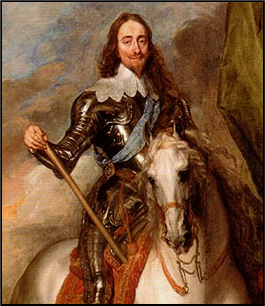 xxxxxCharles I on Horseback, executed in 1638 and now in the National Gallery, London, is generally recognised as the equestrian portrait that best succeeds in artfully conveying that sense of majesty and regal authority that the king sought to project. Also successful in this respect, however, is Charles I on Horseback with Seigneur de St. Antoine (his riding master). This work (detail illustrated) completed in 1633 and now in the Royal Collection, adds triumph to majesty, an aspect which, in fact, he failed to achieve. Other paintings of the king, less concerned with image, were brilliant in their detailed study of his features and the revelation of his character, and none more so than the three portraits in one (illustrated below), produced to assist the Italian sculptor Bernini in the making of a marble bust.
xxxxxCharles I on Horseback, executed in 1638 and now in the National Gallery, London, is generally recognised as the equestrian portrait that best succeeds in artfully conveying that sense of majesty and regal authority that the king sought to project. Also successful in this respect, however, is Charles I on Horseback with Seigneur de St. Antoine (his riding master). This work (detail illustrated) completed in 1633 and now in the Royal Collection, adds triumph to majesty, an aspect which, in fact, he failed to achieve. Other paintings of the king, less concerned with image, were brilliant in their detailed study of his features and the revelation of his character, and none more so than the three portraits in one (illustrated below), produced to assist the Italian sculptor Bernini in the making of a marble bust.
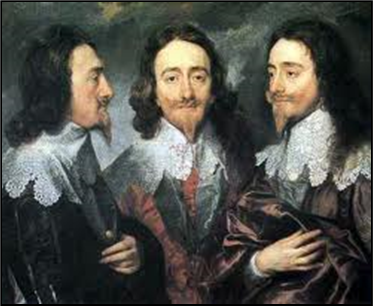 xxxxxIt is not clear why Van Dyke chose to leave his thriving studio in Antwerp, but he might well have been aware of the king's generous plans. He was given a house in Blackfriars -
xxxxxIt is not clear why Van Dyke chose to leave his thriving studio in Antwerp, but he might well have been aware of the king's generous plans. He was given a house in Blackfriars -
XxxxxHis work in England had a profound effect upon English portrait artists far into the 18th century, and founded the school to which, amongst others, both Joshua Reynolds and Thomas Gainsborough were to belong. And the two German portrait painters who came to work in England, Peter Lely and Godfrey Kneller, also drew inspiration from his work.
C1-
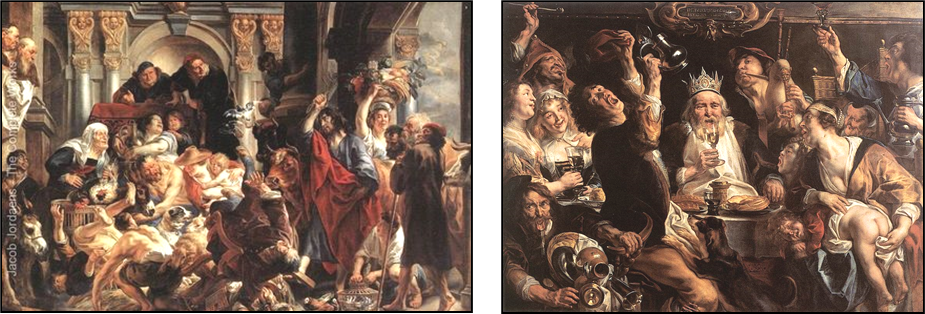


Illustrated here are The Lamentation of Christ, An Apostle, and Charles I’s five eldest children 1637.


